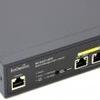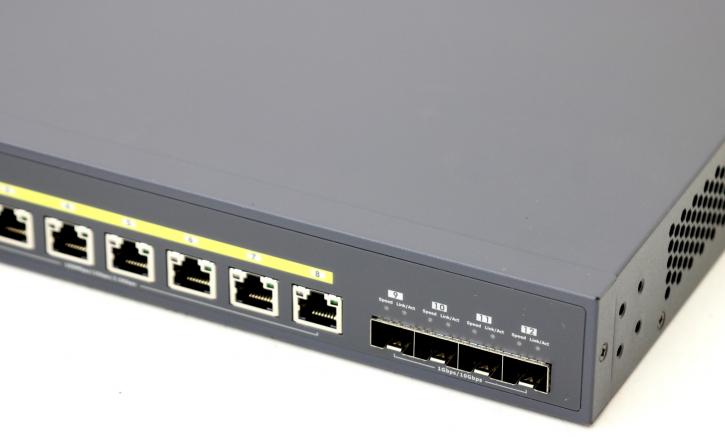Bits, Frames, and Packets
Bits, Frames, and Packets
Let's take a little overview of network equipment. At the bottom of the network food chain, you get the repeater. It does nothing but takes the bits, boost their signal, and send them on their way. Repeaters were the standard way to get around the 100 meter limit for cable. Just above that is the hub, similar to a repeater, and just as dumb, it generally just has lots of ports. Hubs don't do anything to segregate data and threats all the computers attached to it as a single broadcast domain. That is a hub forwards all packets to all ports and leaves it up to the nodes to decide if the packet was for them. Not the most efficient way to network, but it works well for smaller networks. Second from the top is the switch, which is what the ECS 2512FP is. Switches treat each port as an individual broadcast domain, sending data (frames) only to the port that needs it, thus enhancing speed and efficiency. This level of intelligence requires that a switch have some buffer memory and have a little processing be done with each packet that goes in and out. At the top of the network, food-chain is the router. Routers can contain switches. It is the big daddy and uber guru of networks, as it works with the highest level of intelligence, by protocol. Switches are generally a good upgrade if you have lots of hubs and want to extend the life of your network and kick up the speed.
| CAT5 | CAT5e | CAT6 | CAT6e | |
|---|---|---|---|---|
| Max Data Transmission Speed (Mbit/s) | 100 Mbps(100BASE-TX) | 1000 Mbps (with 1000BASE-T) 2500 Mbps (with 2.5GBASE-T) 5000 Mbps (with 5GBASE-T) ** |
5000 Mbps (with 5GBASE-T) 10000 Mbps (with 10GBASE-T)** |
10000 Mbps (with 10GBASE-T) |
| Cable rating (Mhz) | 100MHz | 100MHz | 250 MHz | 500MHz |
| ** It is possible to utilize cables of a lower grade than what is necessary for a 100 m cable when the cable length is shorter. In some cases, it is possible to use 10GBASE-T over a CAT6cable that is 55 meters or less in length. Similarly, 5GBASE-T is intended to be compatible with Cat5e in the vast majority of applications up to 55 meters. | ||||
We started at 100 Mbit/s
My initial encounters with a full Gigabit network remain vivid in my memory. I updated our home network to gigabit speed coming from 100 Mbit roughly 15 years ago, and truly appreciated the increased transfer speeds. The fact however is that gigabit has been around for a long time, too long even; and throughout that period, storage speeds and requirements, as well as connectivity, have exploded in contrast to previous generations. For instance, gigabit is 125 MB/s, even a slow 5400 RPM hard disk these days can deliver 150 MB/s. With NVMe we now can copy in excess of 3GB/sec to even 7 GB/sec, yet over ethernet we remain limited.
Gigabit, for the 99.99% out there is the fastest available connection. And hey, if you are only using your computer and the internet, this is completely OK because your internet connection is still the only limitation you have. However, if you are moving files over your network, particularly to numerous PCs, a 1G or gigabit network is a notable slowdown, and with Intel and AMD now integrating 2.5G network cards in their Z590/Z690 and AMD 500 series chipsets, faster network speeds are becoming a possibility for an increasing number of users. Today I'm taking a look at the EnGenius ECS2512FP, which supports 2.5G with POE and has the capability of supporting SFP+ transceivers for 10G, as well as other features.
The EnGenius ECS2512FP thus has 8 full-duplex 10/100/1000/2500 ports for its connections, so you need to double that up. Most switch crossbars (the backplane) run in the gigahertz range, 120 Gbps for this one. But it is surprising to see that Engenius isn't compromising on speed for the sake of costs. A lot of crossbar bandwidth certainly does work out to the full-duplex 5000 Mbps for each port (2.5G each way).


